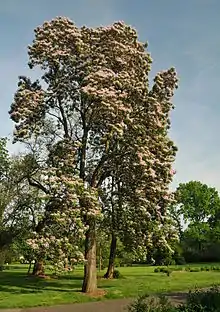Catalpa bungei
Catalpa bungei, commonly known as Manchurian catalpa, is a species of catalpa native to China. The specific epithet honors the botanist Alexander Bunge, who collected the specimens that Carl Anton von Meyer later described.[1] The flowers are arranged in a corymb and are densely spotted with pink. It is cultivated in China, along with C. ovata, for its wood,[2] which is also used for coffins,[3] ancestral tablets,[4] and oars.[5] It also used as an ornamental tree.[1]
| Manchurian catalpa | |
|---|---|
 | |
| Scientific classification | |
| Kingdom: | Plantae |
| Clade: | Tracheophytes |
| Clade: | Angiosperms |
| Clade: | Eudicots |
| Clade: | Asterids |
| Order: | Lamiales |
| Family: | Bignoniaceae |
| Genus: | Catalpa |
| Species: | C. bungei |
| Binomial name | |
| Catalpa bungei | |
References
- Olsen, Richard T.; Kirkbride, Jr., Joseph H. (2010). "Manchurian Catalpa" (PDF). Arnoldia. 68 (2): 75. Retrieved 27 May 2013.
- Liu, W.; Wang, C.; Shen, X.; Liang, H.; Wang, Y.; He, Z.; Zhang, D.; Chen, F. (June 2019). "Comparative transcriptome analysis highlights the hormone effects on somatic embryogenesis in Catalpa bungei". Plant Reproduction. 32 (2): 141–151. doi:10.1007/s00497-018-0349-y. PMID 30421145. S2CID 53288628.
- Wolfram Eberhard The Local Cultures of South and East China, p. 333, at Google Books
- Reginald Fleming Johnston Lion and Dragon in Northern China, p. 235, at Google Books
- Joseph Needham and Colin A. Ronan The Shorter Science and Civilisation in China:, p. 83, at Google Books
External links
- USDA Plants Profile: Catalpa bungei
 Media related to Catalpa bungei at Wikimedia Commons
Media related to Catalpa bungei at Wikimedia Commons Data related to Catalpa bungei at Wikispecies
Data related to Catalpa bungei at Wikispecies

Manchurian catalpa in bloom at the Brooklyn Botanic Garden
This article is issued from Wikipedia. The text is licensed under Creative Commons - Attribution - Sharealike. Additional terms may apply for the media files.